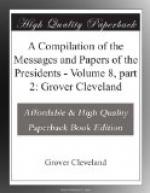formed into the Territory of Indiana, including the
present States of Indiana, Illinois, Michigan, and
Wisconsin, and he was appointed its governor and superintendent
of Indian affairs, which he accepted, and resigned
his seat in Congress. Was reappointed successively
by Presidents Jefferson and Madison. He organized
the legislature at Vincennes in 1805. Held frequent
councils with the Indians, and succeeded in averting
many outbreaks. On September 30, 1809, concluded
a treaty with several tribes by which they sold to
the United States about 3,000,000 acres of land on
the Wabash and White rivers. This and former treaties
were condemned by Tecumseh and other chiefs, and an
outbreak became imminent, which was averted by the
conciliatory course of the governor. In the spring
of 1811 Indian depredations became frequent, and Governor
Harrison recommended the establishment of a military
post at Tippecanoe, and the Government consented.
On September 26 Harrison marched from Vincennes with
about 900 men, including 350 regular infantry, completed
Fort Harrison, near the site of Terre Haute, Ind.,
on October 28, and leaving a garrison there pressed
on toward Tippecanoe. On November 6, when near
that town, was met by messengers demanding a parley,
and a council was proposed for the next day.
At 4 o’clock the following morning a fierce
attack was made by the savages; at daybreak the Indians
were driven from the field. For this victory
he was highly complimented by President Madison in
his message of December 18, 1811, and was also thanked
by the legislatures of Kentucky and Indiana.
On August 25, 1812, soon after war was declared against
Great Britain, was commissioned major-general of the
militia of Kentucky, though not a citizen of that State.
On August 22, 1812, was commissioned a brigadier-general
in the Regular Army, and later was appointed to the
chief command of the Northwestern army, with instructions
to act in all cases according to his own discretion
and judgment. No latitude as great as this had
been given to any commander since Washington.
On March 2, 1813, was commissioned a major-general.
Was in command of Fort Meigs when General Proctor,
with a force of British troops and Indians, laid unsuccessful
siege to it from April 28 to May 9, 1813. Transporting
his army to Canada, he fought the battle of the Thames
on October 5, defeating General Proctor’s army
of 800 regulars and 1,200 Indians, the latter led
by the celebrated Tecumseh, who was killed. This
battle, together with Perry’s victory on Lake
Erie, gave the United States possession of the chain
of lakes above Erie and put an end to the war in uppermost
Canada. For this victory he was praised by President
Madison in his annual message to Congress and by the
legislatures of the different States. Through
a misunderstanding with General John Armstrong, Secretary
of War, he resigned his commission in the Army May
31, 1814. In 1814, and again in 1815, he was
appointed on commissions that concluded Indian treaties,




